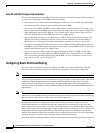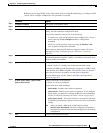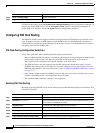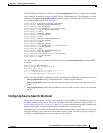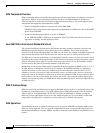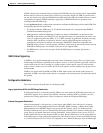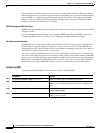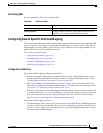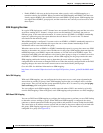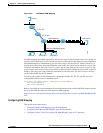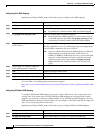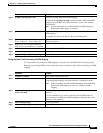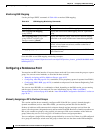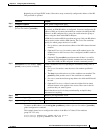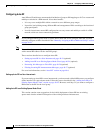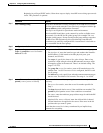
40-18
Cisco ME 3400 Ethernet Access Switch Software Configuration Guide
OL-9639-06
Chapter 40 Configuring IP Multicast Routing
Configuring IP Multicast Routing
• Enable IGMPv3 with care on the last hop router when you rely solely on SSM mapping as a
transition solution for full SSM. When you enable both SSM mapping and IGMPv3 and the hosts
already support IGMPv3 (but not SSM), the hosts send IGMPv3 group reports. SSM mapping does
not support these IGMPv3 group reports, and the router does not correctly associate sources with
these reports.
SSM Mapping Overview
In a typical STB deployment, each TV channel uses one separate IP multicast group and has one active
server host sending the TV channel. A single server can send multiple TV channels, but each to a
different group. In this network environment, if a router receives an IGMPv1 or IGMPv2 membership
report for a particular group, the report addresses the well-known TV server for the TV channel
associated with the multicast group.
When SSM mapping is configured, if a router receives an IGMPv1 or IGMPv2 membership report for a
particular group, the router translates this report into one or more channel memberships for the
well-known sources associated with this group.
When the router receives an IGMPv1 or IGMPv2 membership report for a group, the router uses SSM
mapping to determine one or more source IP addresses for the group. SSM mapping then translates the
membership report as an IGMPv3 report and continues as if it had received an IGMPv3 report. The
router then sends PIM joins and continues to be joined to these groups as long as it continues to receive
the IGMPv1 or IGMPv2 membership reports, and the SSM mapping for the group remains the same.
SSM mapping enables the last hop router to determine the source addresses either by a statically
configured table on the router or through a DNS server. When the statically configured table or the DNS
mapping changes, the router leaves the current sources associated with the joined groups.
Go to this URL for additional information on SSM mapping:
http://www.cisco.com/en/US/products/sw/iosswrel/ps5207/products_feature_guide09186a00801a6d6f.
html
Static SSM Mapping
With static SSM mapping, you can configure the last hop router to use a static map to determine the
sources that are sending to groups. Static SSM mapping requires that you configure ACLs to define
group ranges. Then you can map the groups permitted by those ACLs to sources by using the ip igmp
static ssm-map global configuration command.
You can configure static SSM mapping in smaller networks when a DNS is not needed or to locally
override DNS mappings. When configured, static SSM mappings take precedence over DNS mappings.
DNS-Based SSM Mapping
You can use DNS-based SSM mapping to configure the last hop router to perform a reverse DNS lookup
to determine sources sending to groups. When DNS-based SSM mapping is configured, the router
constructs a domain name that includes the group address and performs a reverse lookup into the DNS.
The router looks up IP address resource records and uses them as the source addresses associated with
this group. SSM mapping supports up to 20 sources for each group. The router joins all sources
configured for a group (see
Figure 40-3).



